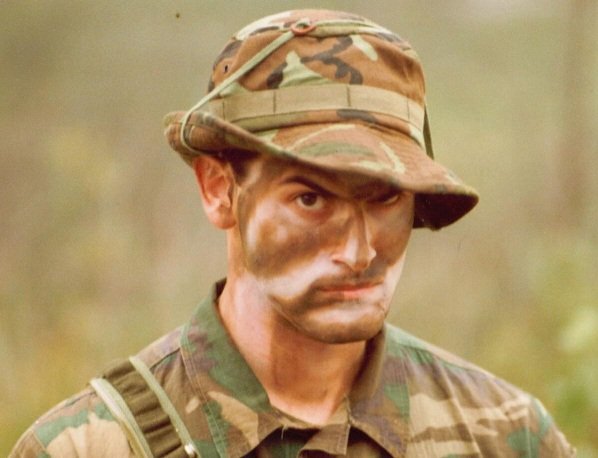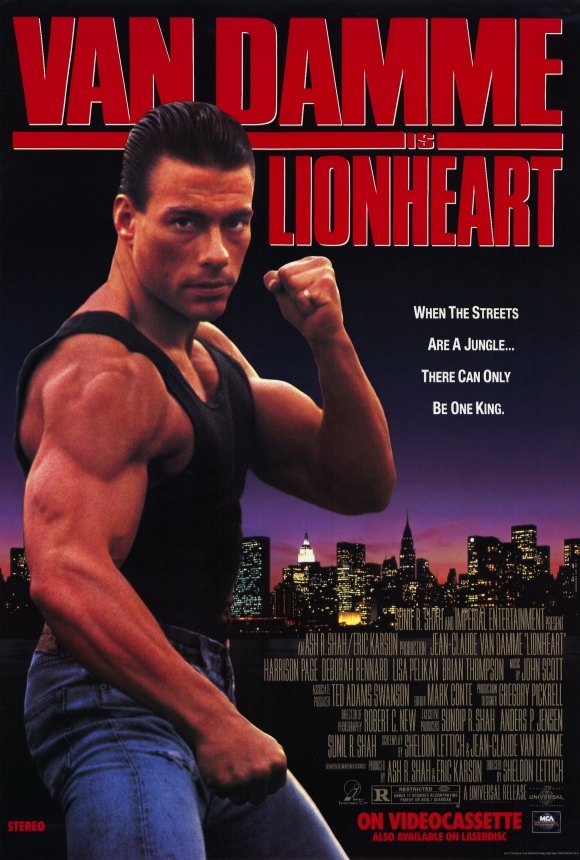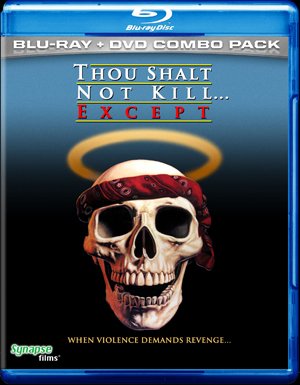SGT. BECKER'S WAR: An Interview With Josh Becker, Part 2
If you're a fan of Thou Shalt Not Kill... Except, you're in for a big treat. The second part of Schlockmania's interview with Josh Becker is devoted entirely to a dozen questions about this cult favorite, which is currently available in a spiffy new blu-ray/DVD combo pack from the good people at Synapse Films. Even if you've studied the plentiful special features on that set, there is still plenty of choice info to be gleaned from the following Q&A session. Many thanks to Mr. Becker for his kind participation in this chat - and special thanks to friend of Schlockmania Jack Perez for setting it all up.If you missed out on Part 1 of this interview, click here to check it out. You've been quoted as saying you prefer Stryker's War, the original 8mm version of the Thou Shalt Not Kill Except story, to the finished film. Could you please explain why? JB: Well, first of all it stars Bruce, who’s one of my favorite actors and a joy to work with; second, it was a new idea at the time in 1980 and we were all highly inspired to make it. When I remade it four years later it was out of sheer desperation and we weren’t nearly as inspired. As always, my ambitions were much higher than my budget, so I kept not getting the things I needed, like decent weapons and a rational looking Vietnamese village. We did the best we could under the circumstances, but I would probably have been much better off making “Lunatics,” which was mainly two actors in a room, not that I’d written it yet.
You've been quoted as saying you prefer Stryker's War, the original 8mm version of the Thou Shalt Not Kill Except story, to the finished film. Could you please explain why? JB: Well, first of all it stars Bruce, who’s one of my favorite actors and a joy to work with; second, it was a new idea at the time in 1980 and we were all highly inspired to make it. When I remade it four years later it was out of sheer desperation and we weren’t nearly as inspired. As always, my ambitions were much higher than my budget, so I kept not getting the things I needed, like decent weapons and a rational looking Vietnamese village. We did the best we could under the circumstances, but I would probably have been much better off making “Lunatics,” which was mainly two actors in a room, not that I’d written it yet. On the commentary track for TSNKE, you reference the fact that you tried to make another film between the two tries necessary to launch TSNKE. Could you tell us anything about that film?JB: It was the feature-length version of our short film, “Cleveland Smith Bounty Hunter.” Scott Spiegel and I put a lot of work into the screenplay, which I still think is loaded with good gags, then we spent two years trying to raise the money. Alas, we didn’t pull it off. But we had raised about $18,000, so we used that money to make TSNKE.On that track, you also reference how you ran out of cash after your first six days. For the sake of giving readers a cautionary tale, how did this happen and how did you avoid having the same problem again once you resumed the shoot?
On the commentary track for TSNKE, you reference the fact that you tried to make another film between the two tries necessary to launch TSNKE. Could you tell us anything about that film?JB: It was the feature-length version of our short film, “Cleveland Smith Bounty Hunter.” Scott Spiegel and I put a lot of work into the screenplay, which I still think is loaded with good gags, then we spent two years trying to raise the money. Alas, we didn’t pull it off. But we had raised about $18,000, so we used that money to make TSNKE.On that track, you also reference how you ran out of cash after your first six days. For the sake of giving readers a cautionary tale, how did this happen and how did you avoid having the same problem again once you resumed the shoot? JB: We spent the first week shooting all of the biggest scenes with the most extras, props, costumes, etc. Having miraculously gotten through that, Scott and I both went and begged our families for some money, which they graciously gave us. From there on out the scenes got progressively smaller, with less actors, less extras, less costumes and everything else. After a couple more weeks we had most of the scenes shot, but we were still missing a lot of the inserts, so we wrapped principal photography and with a highly reduced crew – mainly me, Scott, Gary Jones (the FX supervisor), Paul Harris (the assistant editor) and Bruce (the supervising sound editor) – we picked up all the rest of the shots.Your co-writer on TSNKE was Sheldon Lettich, who went on to a very successful career writing scripts for Jean-Claude Van Damme films. How did you two end up working together and what did he bring to the table on TSNKE?
JB: We spent the first week shooting all of the biggest scenes with the most extras, props, costumes, etc. Having miraculously gotten through that, Scott and I both went and begged our families for some money, which they graciously gave us. From there on out the scenes got progressively smaller, with less actors, less extras, less costumes and everything else. After a couple more weeks we had most of the scenes shot, but we were still missing a lot of the inserts, so we wrapped principal photography and with a highly reduced crew – mainly me, Scott, Gary Jones (the FX supervisor), Paul Harris (the assistant editor) and Bruce (the supervising sound editor) – we picked up all the rest of the shots.Your co-writer on TSNKE was Sheldon Lettich, who went on to a very successful career writing scripts for Jean-Claude Van Damme films. How did you two end up working together and what did he bring to the table on TSNKE? JB: Sheldon also directed a number of the Van Damme films, like “Lionheart” and “Double Impact.” Sheldon was one of the first friends I made in L.A. when I initially moved there in 1976. Sheldon had served as a Marine in Vietnam and therefore had all the first-hand information about the war, the country and what meant to be a Marine. So when I came up with the idea of the Marines versus the Manson family in 1979, when Sheldon and I were both fledgling screenwriters, I naturally pitched it to him. His first response was, “Wow, is that a stupid idea.” He then called me later that evening and said, “Hey, maybe it’s not that stupid after all. Let’s write it.” Sadly, the one draft we wrote together, entitled “Bloodbath,” was far too serious for my liking, and Sheldon had a lot of serious, unresolved issues regarding the war (he was there in 1969-70, so it hadn’t been all that long). Not to mention the script came out to nearly 200 pages. I was very disappointed, and Sheldon immediately moved on to another Vietnam war script and lost interest in “Bloodbath.” I then completely rewrote the story with Bruce as we drove back from making “Evil Dead,” and that’s essentially what the film became.
JB: Sheldon also directed a number of the Van Damme films, like “Lionheart” and “Double Impact.” Sheldon was one of the first friends I made in L.A. when I initially moved there in 1976. Sheldon had served as a Marine in Vietnam and therefore had all the first-hand information about the war, the country and what meant to be a Marine. So when I came up with the idea of the Marines versus the Manson family in 1979, when Sheldon and I were both fledgling screenwriters, I naturally pitched it to him. His first response was, “Wow, is that a stupid idea.” He then called me later that evening and said, “Hey, maybe it’s not that stupid after all. Let’s write it.” Sadly, the one draft we wrote together, entitled “Bloodbath,” was far too serious for my liking, and Sheldon had a lot of serious, unresolved issues regarding the war (he was there in 1969-70, so it hadn’t been all that long). Not to mention the script came out to nearly 200 pages. I was very disappointed, and Sheldon immediately moved on to another Vietnam war script and lost interest in “Bloodbath.” I then completely rewrote the story with Bruce as we drove back from making “Evil Dead,” and that’s essentially what the film became. Sam Raimi stars as the villain, appearing between directing The Evil Dead and Crimewave. How did he become involved in acting capacity?JB: Sam acts in all of my early films, usually as the bad guy. Sam’s a scenery chewer from way back, so I never thought of anyone but him for Manson. Personally, I think he’s great in the part (both times), although the New York Daily News in their year-end film awards gave Sam “Worst performance by a director,” which I still think was very unfair.
Sam Raimi stars as the villain, appearing between directing The Evil Dead and Crimewave. How did he become involved in acting capacity?JB: Sam acts in all of my early films, usually as the bad guy. Sam’s a scenery chewer from way back, so I never thought of anyone but him for Manson. Personally, I think he’s great in the part (both times), although the New York Daily News in their year-end film awards gave Sam “Worst performance by a director,” which I still think was very unfair. It's also worth noting that he gives a truly wild performance. How much of this was your direction and how much came from him? JB: It all came from him. The only direction Sam needed was “Action.”You also worked with actor Ted Raimi on this film, someone who would you go on to work with a lot in the years that followed. What's the actor/director relationship like when you two work together?JB: We never stop laughing. Actors like Ted, Bruce and Sam bring so much with them to the part, as well as amazing energy, that they don’t need much direction, other than “Here’s your mark.”The finale of TSNKE offers an impressive set of setpieces that blend ultraviolence with a darkly-humored kind of slapstick. How much of this was in the script and how much was actually worked out during the shooting?
It's also worth noting that he gives a truly wild performance. How much of this was your direction and how much came from him? JB: It all came from him. The only direction Sam needed was “Action.”You also worked with actor Ted Raimi on this film, someone who would you go on to work with a lot in the years that followed. What's the actor/director relationship like when you two work together?JB: We never stop laughing. Actors like Ted, Bruce and Sam bring so much with them to the part, as well as amazing energy, that they don’t need much direction, other than “Here’s your mark.”The finale of TSNKE offers an impressive set of setpieces that blend ultraviolence with a darkly-humored kind of slapstick. How much of this was in the script and how much was actually worked out during the shooting? JB: It’s all in the script. Scott helped me work out some of the violence gags for “Stryker’s War,” then he and I rewrote my script for the short film into a feature and added everything else.One of the best elements of TSNKE is Joe LoDuca's score, which has a rousing main theme worthy of Jerry Goldsmith. It was also the most expensive element of the film. How did LoDuca become involved, what made it so costly and how did you get the money?JB: Joe had already scored “Evil Dead” and I was highly impressed with his work. He and I became good friends and still are (I just had lunch with him an hour ago). My Mom and Dad put up the finishing funds, which is why they get executive
JB: It’s all in the script. Scott helped me work out some of the violence gags for “Stryker’s War,” then he and I rewrote my script for the short film into a feature and added everything else.One of the best elements of TSNKE is Joe LoDuca's score, which has a rousing main theme worthy of Jerry Goldsmith. It was also the most expensive element of the film. How did LoDuca become involved, what made it so costly and how did you get the money?JB: Joe had already scored “Evil Dead” and I was highly impressed with his work. He and I became good friends and still are (I just had lunch with him an hour ago). My Mom and Dad put up the finishing funds, which is why they get executive  producers credits. The reason that the score was expensive was that Joe put together a 65 piece orchestra with a 5 piece ethnic accompaniment. He knocked out the recording of the score in a day, but that’s still a lot of musicians. And I still think Joe’s score is the single best thing about the film.A lot of people first became aware of TSNKE when it was released on home video. How did it do during its initial video release and were you able to turn a profit?JB: Unlike any other film I’ve ever made, TSNKE had an 18 city theatrical release with 25 prints. I never saw a cent from that, but it convinced Prism Video to pay $50,000 for the video rights. It moved 90,000 copies on VHS, then it was sold to Good Time Video and moved another 100,000 copies. I didn’t actually go into profit on the film until the next video sale to Anchor Bay in 1995. Anchor Bay repurchased the rights for another 5 years, and now Synapse Films has the rights and is releasing the Blu-Ray. One way or another that film has stayed in release for 27 years, which is a bloody miracle.On your website, there is a picture of a 42nd street marquee where TSNKE was shown. Did you attend any of those screenings and, if so, what was the experience like?
producers credits. The reason that the score was expensive was that Joe put together a 65 piece orchestra with a 5 piece ethnic accompaniment. He knocked out the recording of the score in a day, but that’s still a lot of musicians. And I still think Joe’s score is the single best thing about the film.A lot of people first became aware of TSNKE when it was released on home video. How did it do during its initial video release and were you able to turn a profit?JB: Unlike any other film I’ve ever made, TSNKE had an 18 city theatrical release with 25 prints. I never saw a cent from that, but it convinced Prism Video to pay $50,000 for the video rights. It moved 90,000 copies on VHS, then it was sold to Good Time Video and moved another 100,000 copies. I didn’t actually go into profit on the film until the next video sale to Anchor Bay in 1995. Anchor Bay repurchased the rights for another 5 years, and now Synapse Films has the rights and is releasing the Blu-Ray. One way or another that film has stayed in release for 27 years, which is a bloody miracle.On your website, there is a picture of a 42nd street marquee where TSNKE was shown. Did you attend any of those screenings and, if so, what was the experience like? JB: I did not attend any of the 42nd St. grindhouse showings, although I did go to many of the theaters where it was showing here in Detroit, and some of them were pretty disreputable. It played well with that crowd. It played at one Detroit drive-in for over two months.What are the most important lessons you learned about filmmaking, both as a craft and a business, while making TSNKE?JB: A. That I could make a feature film; B. that freaking out on the set wasn’t going to do me the slightest bit of good; C. that each actor needs to be handled individually; D. that making money with indie films was a lot more difficult than it seemed; E. it was time to move on to my next film.
JB: I did not attend any of the 42nd St. grindhouse showings, although I did go to many of the theaters where it was showing here in Detroit, and some of them were pretty disreputable. It played well with that crowd. It played at one Detroit drive-in for over two months.What are the most important lessons you learned about filmmaking, both as a craft and a business, while making TSNKE?JB: A. That I could make a feature film; B. that freaking out on the set wasn’t going to do me the slightest bit of good; C. that each actor needs to be handled individually; D. that making money with indie films was a lot more difficult than it seemed; E. it was time to move on to my next film.


